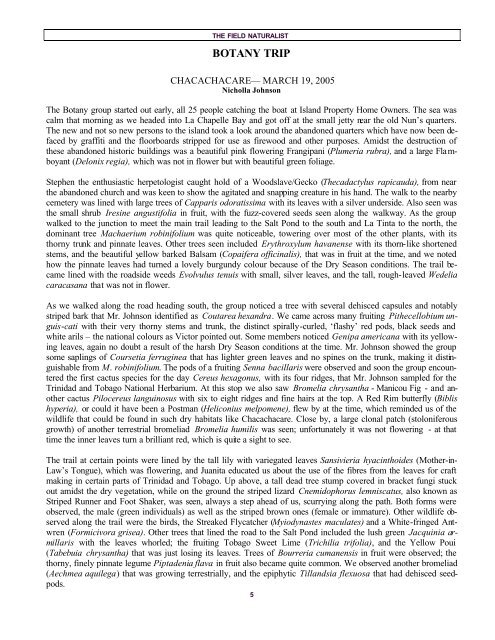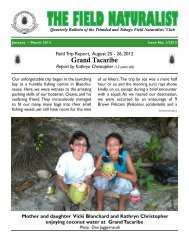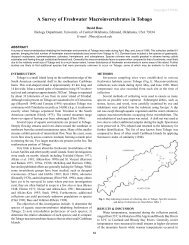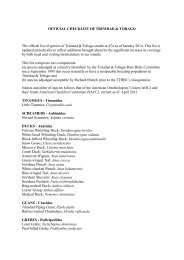Vol 2 - The Trinidad and Tobago Field Naturalists' Club
Vol 2 - The Trinidad and Tobago Field Naturalists' Club
Vol 2 - The Trinidad and Tobago Field Naturalists' Club
You also want an ePaper? Increase the reach of your titles
YUMPU automatically turns print PDFs into web optimized ePapers that Google loves.
THE FIELD NATURALISTBOTANY TRIPCHACACHACARE— MARCH 19, 2005Nicholla Johnson<strong>The</strong> Botany group started out early, all 25 people catching the boat at Isl<strong>and</strong> Property Home Owners. <strong>The</strong> sea wascalm that morning as we headed into La Chapelle Bay <strong>and</strong> got off at the small jetty near the old Nun’s quarters.<strong>The</strong> new <strong>and</strong> not so new persons to the isl<strong>and</strong> took a look around the ab<strong>and</strong>oned quarters which have now been defacedby graffiti <strong>and</strong> the floorboards stripped for use as firewood <strong>and</strong> other purposes. Amidst the destruction ofthese ab<strong>and</strong>oned historic buildings was a beautiful pink flowering Frangipani (Plumeria rubra), <strong>and</strong> a large Flamboyant(Delonix regia), which was not in flower but with beautiful green foliage.Stephen the enthusiastic herpetologist caught hold of a Woodslave/Gecko (<strong>The</strong>cadactylus rapicauda), from nearthe ab<strong>and</strong>oned church <strong>and</strong> was keen to show the agitated <strong>and</strong> snapping creature in his h<strong>and</strong>. <strong>The</strong> walk to the nearbycemetery was lined with large trees of Capparis odoratissima with its leaves with a silver underside. Also seen wasthe small shrub Iresine angustifolia in fruit, with the fuzz-covered seeds seen along the walkway. As the groupwalked to the junction to meet the main trail leading to the Salt Pond to the south <strong>and</strong> La Tinta to the north, thedominant tree Machaerium robinifolium was quite noticeable, towering over most of the other plants, with itsthorny trunk <strong>and</strong> pinnate leaves. Other trees seen included Erythroxylum havanense with its thorn-like shortenedstems, <strong>and</strong> the beautiful yellow barked Balsam (Copaifera officinalis), that was in fruit at the time, <strong>and</strong> we notedhow the pinnate leaves had turned a lovely burgundy colour because of the Dry Season conditions. <strong>The</strong> trail becamelined with the roadside weeds Evolvulus tenuis with small, silver leaves, <strong>and</strong> the tall, rough-leaved Wedeliacaracasana that was not in flower.As we walked along the road heading south, the group noticed a tree with several dehisced capsules <strong>and</strong> notablystriped bark that Mr. Johnson identified as Coutarea hex<strong>and</strong>ra. We came across many fruiting Pithecellobium unguis-catiwith their very thorny stems <strong>and</strong> trunk, the distinct spirally-curled, ‘flashy’ red pods, black seeds <strong>and</strong>white arils – the national colours as Victor pointed out. Some members noticed Genipa americana with its yellowingleaves, again no doubt a result of the harsh Dry Season conditions at the time. Mr. Johnson showed the groupsome saplings of Coursetia ferruginea that has lighter green leaves <strong>and</strong> no spines on the trunk, making it distinguishablefrom M. robinifolium. <strong>The</strong> pods of a fruiting Senna bacillaris were observed <strong>and</strong> soon the group encounteredthe first cactus species for the day Cereus hexagonus, with its four ridges, that Mr. Johnson sampled for the<strong>Trinidad</strong> <strong>and</strong> <strong>Tobago</strong> National Herbarium. At this stop we also saw Bromelia chrysantha - Manicou Fig - <strong>and</strong> anothercactus Pilocereus languinosus with six to eight ridges <strong>and</strong> fine hairs at the top. A Red Rim butterfly (Biblishyperia), or could it have been a Postman (Heliconius melpomene), flew by at the time, which reminded us of thewildlife that could be found in such dry habitats like Chacachacare. Close by, a large clonal patch (stoloniferousgrowth) of another terrestrial bromeliad Bromelia humilis was seen; unfortunately it was not flowering - at thattime the inner leaves turn a brilliant red, which is quite a sight to see.<strong>The</strong> trail at certain points were lined by the tall lily with variegated leaves Sansivieria hyacinthoides (Mother-in-Law’s Tongue), which was flowering, <strong>and</strong> Juanita educated us about the use of the fibres from the leaves for craftmaking in certain parts of <strong>Trinidad</strong> <strong>and</strong> <strong>Tobago</strong>. Up above, a tall dead tree stump covered in bracket fungi stuckout amidst the dry vegetation, while on the ground the striped lizard Cnemidophorus lemniscatus, also known asStriped Runner <strong>and</strong> Foot Shaker, was seen, always a step ahead of us, scurrying along the path. Both forms wereobserved, the male (green individuals) as well as the striped brown ones (female or immature). Other wildlife observedalong the trail were the birds, the Streaked Flycatcher (Myiodynastes maculates) <strong>and</strong> a White-fringed Antwren(Formicivora grisea). Other trees that lined the road to the Salt Pond included the lush green Jacquinia armillariswith the leaves whorled; the fruiting <strong>Tobago</strong> Sweet Lime (Trichilia trifolia), <strong>and</strong> the Yellow Poui(Tabebuia chrysantha) that was just losing its leaves. Trees of Bourreria cumanensis in fruit were observed; thethorny, finely pinnate legume Piptadenia flava in fruit also became quite common. We observed another bromeliad(Aechmea aquilega) that was growing terrestrially, <strong>and</strong> the epiphytic Till<strong>and</strong>sia flexuosa that had dehisced seedpods.5








